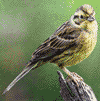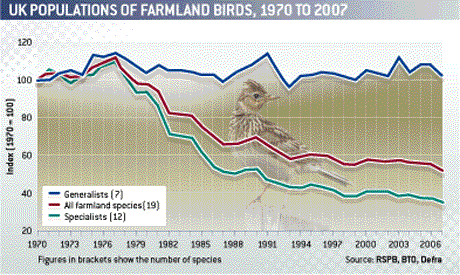Birds in decline: How do they work that out?

Recent figures from the government’s Farmland Bird Indicator (FBI) show a surprising downturn in breeding bird numbers, leading to claim and counter-claim about the role of modern agriculture and the effectiveness of the index. RSPB agricultural policy officer Gareth Morgan answers farmers’ questions.
These questions were adapted from questions posted on an FWi forum and e-mailed to Farmers Weekly. Are you satisfied with the RSPB’s answers? Do you have other concerns about the use of farmland bird indicators? Join our forum debate |
|---|
What is the definition of a farmland bird and why are common species such as crow, sparrowhawk, collared dove, barn owl, mallard and chaffinch not on the list?
The 19 farmland species on the FBI – which include 12 “specialists” and seven “generalists” – are representative of birds dependent on lowland farmland. Many other species are common on farmland, but the FBI selects farmland birds on the basis that they are not widespread in other habitats. The index is therefore particularly useful in assessing the populations of those birds where farming makes a particular and unique contribution.
What is the difference between “specialists” and “generalists”?
The definition of specialist and generalist species is based on scientific criteria. While the selection will inevitably involve a degree of judgment, it is useful to separate out those species found on farmland that are more “generalist”, such as goldfinch and rook, from “specialists” that are intimately linked to farmland, such as skylark and yellowhammer.

Why is the FBI limited to only 19 species when most farmers see more than 50 species on their farms?
Many of these other species, such as robin, blackbird, chaffinch and carrion crow, use a variety of habitats. They are found in towns, gardens and woodlands, as well as farmland. While their populations will be affected by the availability of food and nesting habitat on farmland, their numbers will not be as sensitive to changes in farming. Farmland specialists have fared much worse over the last four decades than farmland generalists, indicating that factors specific to farmland are the probable cause.
How are bird counts actually performed and how are they authenticated?
The Breeding Bird Survey (BBS) monitors population trends of all common breeding birds in the UK. This is compiled by the British Trust for Ornithology (BTO), and the fieldwork is largely completed by BTO volunteers. Twice each spring, surveyors count all birds recorded in two 1km transects through selected 1km squares. Results from more than 2500 squares, spread randomly across the UK, are combined to provide a rigorous estimate of bird population trends. The figures are published by DEFRA, which is satisfied that the whole process is scientifically sound.
Why are over-wintering birds not on the FBI? The number of wintering lapwing has increased over the last 30 years, but the number of summer nesting ones has gone down and it is only these that go on the list.
Many farmland birds, including lapwing, starling and finches, undertake large-scale seasonal migrations to or from the British Isles. For many species, the scale of this migration depends on the severity of winter weather. Thus, the numbers of many birds on UK farmland during winter depend more on the size of European populations and the severity of prevailing weather conditions across Europe, rather than the suitability of UK farmland.
When you do the counts, do you only include stationary, landed birds? If so what happens to swifts and swallows?
Flying birds are recorded separately, so distinction is made between birds actually using the square, and those that are just flying over it. However, it is recognised that birds feeding, hunting or displaying may all be making use of the square despite only being recorded in flight. Skylark and kestrel are the only FBI species likely to be frequently recorded in flight. BBS survey techniques are considered reliable for these species.
What has happened to the farmland bird populations on the areas now under RSPB control?
At our arable farm in Cambridgeshire, we have managed to more than double numbers of skylark, linnet and yellowhammer since 2000, when national trends over this period have all continued to decline. This has largely been through using Entry Level Stewardship measures while maintaining the financial return to the RSPB.
These questions were adapted from questions posted on an FWi forum and e-mailed to Farmers Weekly. Are you satisfied with the RSPB’s answers? Do you have other concerns about the use of farmland bird indicators? Join our forum debate |
|---|
What should farmers do to boost farmland bird numbers, without compromising their productivity and profitability?
If the right measures are put in place to provide nesting habitat, summer food and winter food at the right scale on each farm, we are confident that this will make all the difference. Good farming practice such as rotational hedge and ditch management, coupled with creation of habitats such as wild bird cover and nectar flower mixtures, can also attract new species
Will the RSPB come to my farm to advise on farmland birds?
The RSPB has a network of staff advising farmers on how to create and manage habitats to boost farmland bird numbers using agri-environment schemes. Trained volunteers are also available to give free surveys – though due to high demand there may be a delay in visiting individual farms.
